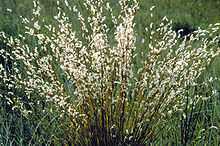Andropogoneae
| Andropogoneae | |
|---|---|
 | |
| Andropogon scoparius | |
| Scientific classification | |
| Kingdom: | Plantae |
| (unranked): | Angiosperms |
| (unranked): | Monocots |
| (unranked): | Commelinids |
| Order: | Poales |
| Family: | Poaceae |
| Subfamily: | Panicoideae |
| Tribe: | Andropogoneae Dumort. |
| Genera | |
|
See text | |
The Andropogoneae are a tribe of grasses (family Poaceae) widespread throughout tropical and temperate regions. They use C4 carbon fixation physiology. All members of this tribe specifically use the NADP–malic enzyme subtype of C4 photosynthesis. This tribe is commonly referred to as the sorghum tribe. Genera belonging to this tribe include: Andropogon, Bothriochloa, Chrysopogon, Coix, Dicanthium, Saccharum, Miscanthus, Schizachyrium, Sorghum, Zea, Sorghastrum, Tripsacum, Heteropogon, Trachypogon, Imperata, and Themeda. Occurrence of this grass is abundant in the tropical savannas of India, Australia, Africa, and South America.
The popular farmed sugarcane is derived from this tribe, as well as the very important food crops maize (Indian corn) and sorghum. These grasses as mentioned originated in West Africa with tropical humidity and elevated temperatures the most abundant feature of the region. The Sorghum Tribe of grasses and sedges is one of the most efficient photosynthetic organisms on earth with the production of sugars the well reheresed domain of Andropogoneae.